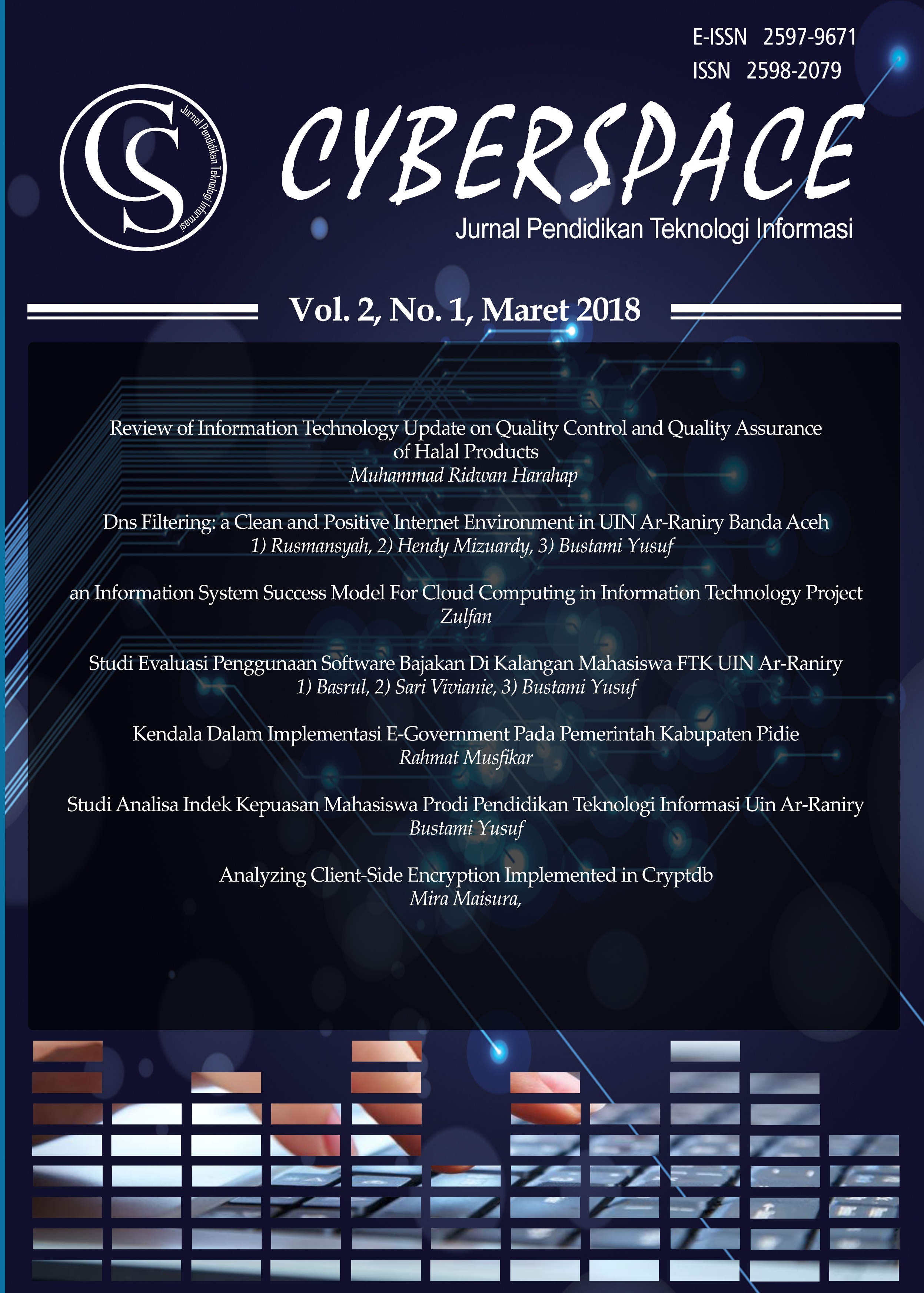STUDI EVALUASI PENGGUNAAN SOFTWARE BAJAKAN DI KALANGAN MAHASISWA FTK UIN AR-RANIRY
DOI:
https://doi.org/10.22373/cs.v2i1.2663Keywords:
Pirated software, Student, UnderstandingAbstract
The use of pirated computer software among univetrsity’s students today is very vulnerable. This is due to two factors, namely; 1) the lack of awareness of the students from type of software they use, 2) and also the lack of understanding of the students about halal-haram in using pirated software. In this study, the authors intends to know the awareness and understanding of computer users, especially among students of pirated software both in terms of impact, legal, or risk from the use of pirated software. The study involved 200 students of the Faculty of Tarbiyah and Teacher Training of Ar-raniry State Islamic University of Banda Aceh, as selected by random. The results of this study showed 36% of students do not understand about pirated software and almost 65% of students are not aware of the risks caused by the use of pirated software and the legal dangers of the use of pirated software. In addition 62% of students currently using pirated software want to switch to using original software or opensource software.References
Anugrah Hajrianto. Skripsi, “Pemakaian Software Bajakan Sebagai Sarana Pendidikan Di Lingkungan Fakultas Syariah Dan Hukum Uin Sunan Kalijaga Yogyakartaâ€. Universitas Islam Negeri Sunan Kalijaga, Yogjakarta, 2014.
Dony Novaliendry (2011) “Multimedia Pembelajaran Bahasa Mandarin Dan Website Promosiâ€. Jurnal Teknologi Informasi & Pendidikan ISSN :2086-4981 Vol. 3, No.1.
Fiska Kusumawati. 2013. Teknologi Informasi Dan Komunikasi. Sidoarjo: Masmedia.
Tim Visi Yustisia, 2015, Panduan Resmi Hak Cipta dari mendaftar, melindungi, hingga menyelesaikan sengketa, Visimedia, Jakarta.
Jarot Setyaji, 2010, Buku Pintar Menguasai Komputer & Laptop, Jakarta: mediakita Raya Fahreza, 2008, Belajar Mudah merakit komputer untuk pemula, Yogyakarta: Penerbit MediaKom.
Duwi Priyatno, 2012, Panduan Lengkap Komputer: PC, Laptop & Tablet, Jakarta: Media Pusindo.
Ahmad Mardalis & Dharma Putra S, 2012, Faktor-Faktor yang Mempengaruhi Penggunaan Software Bajakan di Kalangan Mahasiswa, BENEFIT Jurnal Manajemen dan Bisnis, Vol. 16 No. 2, hal.99-105
Windarto, 2015, Perlindungan Hukum Terhadap Program Komputer Ditinjau dari Undang-Undang Nomor 28 Tahun 2014 Tentang Hak Cipta, Jurnal Ilmu Hukum Vol. 6 No. 2
Al Sentot Sudarwanto, 2009, Cyber-Bullying Kejahatan Dunia Maya yang Terlupakan, Jurnal Hukum Pro Justitia, Vol. 27 No. 1
Maya Sari., Rhiza S. Sadjad., & M. Nadjib HM. (2011) “Tinjauan Hukum Media MassaTerhadap Penggunaan Software Bajakan Dikalangan Mahasiswa Di Kota Makassarâ€. Jurnal komunikasi KAREBA Vol. 1, No.4
Nurdin Yunus, M. Nur Rasyid, dan Sanusi Bintang, 2014, Perlindungan Hukum atas Hak Cipta Program Komputer (Kajian Normatif dan Sosiologis di Kota Banda Aceh), Jurnal Ilmu Hukum Vol.2, No.2
Handy Awaludin Prandika, 2015, Analisa Perlindungan Hak Cipta di Jaringan Internet Menurut Undang-Undang No 19 Tahun 2002 tentan Hak Cipta, Lex Privatum, Vol. III, No.1
Suyud Margono, 2012, Prinsip Deklaratif Pendaftaran Hak Cipta: Kontradiksi Kaedah Pendaftaran Ciptaan dengan Asas Kepemilikan Publikasi Pertama Kali, Rechts Vinding, Vol.1 No. 2, Agustus 2012,hlm. 237-255
Dwi Prihatini, 2011, Etika dan Penggunaan Teknologi Informasi: Faktor-faktor yang mempengaruhi intensi mahasiswa Akuntansi untuk melakukan pembajakan perangkat lunak, Jurnal Ilmiah SISFOTENIKA Vol.1, No. 1 Januari 2011.
Bima Subrata Tamamile, 2016, Perlindungan Hukum Terhadap Hak Cipta Perangkat Lunak Dari Tindakan Pembajakan, Lex et SOcietatis, Vo1. IV, No. 5 Mei 2016
Undang-Undang Republik Indonesia Nomor 19 Tahun 2002 Tentang Hak Cipta
Fatwa Majelis Ulama Indonesia Nomor: 1/Munas Vii/Mui/5/2005 Tentang Perlindungan Hak Kekayaan Intelektual (Hki)
Downloads
Published
Issue
Section
License
Authors who publish with Cyberspace Journal agree to the following terms:
- Authors retain copyright and grant the journal right of first publication with the work simultaneously licensed under a Creative Commons Attribution License that allows others to share the work with an acknowledgement of the work's authorship and initial publication in this journal.
- Authors are able to enter into separate, additional contractual arrangements for the non-exclusive distribution of the journal's published version of the work (e.g., post it to an institutional repository or publish it in a book), with an acknowledgement of its initial publication in this journal.
- Authors are permitted and encouraged to post their work online (e.g., in institutional repositories or on their website) prior to and during the submission process, as it can lead to productive exchanges, as well as earlier and greater citation of published work (See The Effect of Open Access).



















